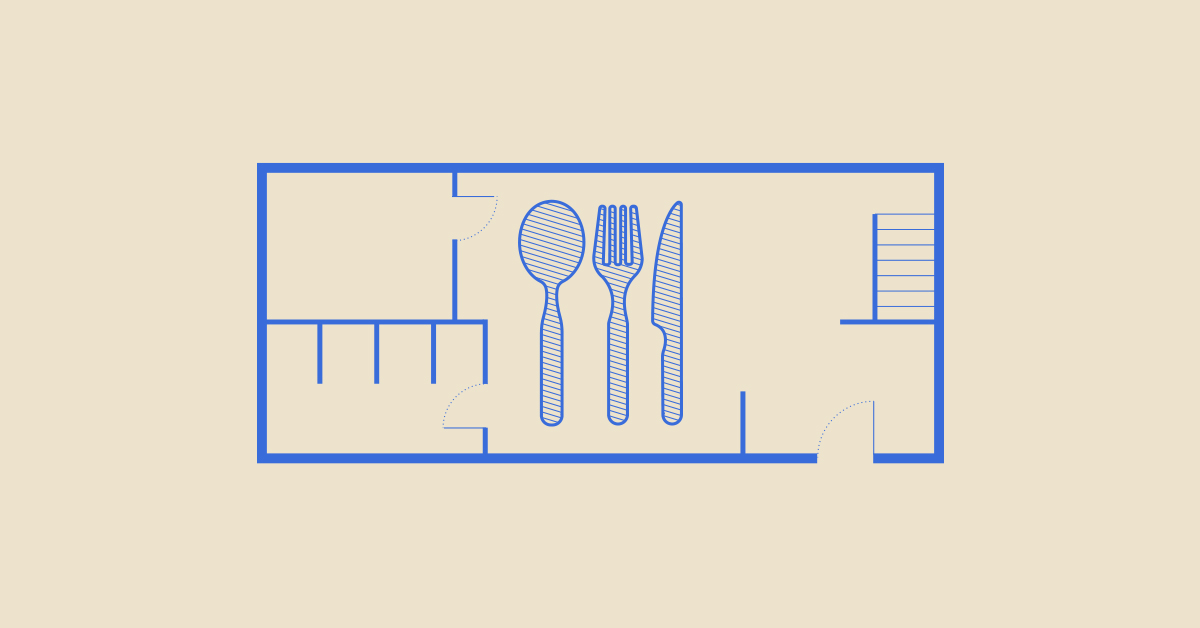
Few customers probably give a second thought to a restaurant’s floor plan, but the configuration of seating, bar and kitchen areas can make a huge difference in how patrons experience the space and how efficiently staff can move through it during a service.
A well-designed restaurant floor plan can increase a restaurant’s profit margins by enabling servers to move between the front and back of house faster, serve customers more efficiently and turn tables faster.
Employees refer to a restaurant’s floor plan every shift. It’s an important tool for daily operations and it’s worth taking the time to create a great one the first time around. In this article, you’ll learn:
- What is a restaurant floor plan?
- Why do restaurants need a floor plan?
- Who designs a restaurant floor plan?
- When should you create your restaurant floor plan?
- Restaurant floor plan considerations
- Restaurant floor plan must-have’s
Let’s get started!
The point of sale for modern restaurants
Build customisable digital floor plans and menus, track sales and inventory and more with Lightspeed’s complete restaurant management platform.
What is a restaurant floor plan?
A restaurant floor plan is a blueprint that maps out your entire restaurant layout. It shows the distance and relationship between rooms, tables, service and waiting areas, payment stations, bar and more. They also show where fixtures like water heaters, doors, electrical outlets and furnaces are located.
Why do restaurants need a floor plan?
A restaurant floor plan is an important tool that helps service staff like waiters, hosts, barbacks and bartenders orient themselves, the customers they serve and the tools they need to do their job. It also helps new hires understand the restaurant space: where the waiting area, bar, dining area, prep area, kitchen, storage, restrooms and dish pit are located.
Who designs a restaurant floor plan?
Hiring a professional architect and interior designer with restaurant industry experience is often well worth the investment. Your restaurant floor plan needs to take building codes and regulations, and a professional who already knows them is far less likely to make a costly mistake.
While an architect is trained to make sure a restaurant is structurally sound, interior designers are trained to design a beautiful, functional space within those regulations. That’s why we suggest hiring both when designing your restaurant interior. Together, they can help you bring your vision to life. Both architects and interior designers possess the following skills:
- A strong understanding of space planning (depending on their level of experience.)
- Up-to-date knowledge of your state or province’s building codes and regulations.
- Experience using professional-grade design software.
- Problem-solving and the foresight to spot and fix red flags before they become a bigger problem.
- Established connections with table, seating, storage, counter space and lighting manufacturers.
- A comprehensive understanding of materials, furnishings and finishes.
- Inherent creativity and knowledge gained through experience that can help you turn an idea into a reality.
While we suggest investing in professional help, here are some restaurant floor plan software options if you opt to create one yourself:
When should you create your restaurant floor plan?
You can’t create an accurate floor plan without a commercial space. As a result, restaurant floor plans are usually built around the same time as when you’re shopping for a commercial restaurant space. Once you’re finalised in which space you’ll set up shop, either you or the architect you hire can start creating the restaurant’s floor plan.
Restaurant floor plan considerations
Before we dive into the must-have sections that your restaurant floor plan should include, let’s take a look at the six essential factors that you need to consider in your restaurant layout decisions:
- Building codes
- Accessibility
- Budget
- Efficiency
- Aesthetic
- Square footage per customer
1. Building codes and regulations
An architect or interior designer with expertise in floor plans can help ensure that yours meets local building codes.
Some of these requirements may not be intuitive to a layperson. For instance, “any foodservice facility in San Francisco has to have a three-compartment sink, a hand-washing sink and drains associated with each of them,” says Dane Bunton, Co-Founder ofStudio BANAA, a San Francisco-based architecture firm. “If you have an ice maker, you’ll have to have a floor drain next to it.”
Restaurant building codes may also require that all surfaces, including ceilings, are washable. “You can’t have open insulation over areas where food is served,” says Michael Antenora, Founder and Principal at Austin-basedAntenora Architects LLP. “There are a lot of things in building and mechanical codes that need to factor into your restaurant’s design.”
2. Accessibility
Making sure that workspaces and dining areas are accessible to those with mobility issues is another important consideration. In 1992, the Disability Discrimination Act (DDA) was passed in Australia, which ensures that all employees and customers benefit from the same level of accessibility.
“Every type of seating around that you provide for ambulatory people has to provide an equivalent experience to those with more limited mobility,” Antenora says. “A good example of that is at the bar counter. Most bars are meant to be where a person can comfortably stand or sit on a high stool. You have to provide a section of the bar that is set up to meet those accessibility guidelines.”
Nastaran Mousavi, Bunton’s Co-Founder at Studio Bana, mentions a few more factors to consider. “All restrooms and work areas also need to be accessible. Essentially, every area of your establishment should be readily accessible for your customers and employees.”
3. Budget
Restaurant build-outs can be expensive, so budgetary concerns may limit how drastically you can alter the space. This is how much it costs to open a restaurant, according to a recent survey from Restaurant Owner:
- Average low total restaurant startup cost: $175,000 (USD)
- Average median total restaurant startup cost: $375,000 (USD)
- Average high total restaurant startup cost: $750,000 (USD)
“Depending on the budget, you might consider limiting the number of walls that we knock out and being efficient in the way that we lay out the plumbing fixtures,” Mousavi says. Arranging a layout around existing plumbing fixtures can save money but it does create some parameters around what type of restaurant layout is possible.
Permitting requirements can also impact budgets. “In San Francisco, it can take up to six months to go through the planning department to get a change of use,” Bunton says. Enlisting the help of an architect during site selection beforeleasing a commercial restaurant space can help minimise these unpleasant surprises.
4. Efficiency
The flow of your staff and customers within the space is also a huge consideration. Will customers order at a counter and have items brought to them? Will they order at the counter and pick up at another area? Or will servers take orders and deliver the food?
“If you can minimise the movement it takes to move plates back and forth from the service area to the kitchen, that’s always better,” says Antenora.
5. Aesthetic
“Once you determine your service model, then we start talking about the experience and style of interior decor,” Antenora says. “What is the vibe of the space? Something that’s homier? Or funky?” The restaurant’s service model, menu and aesthetic all need to collectively make sense to attract customers that fit your desired demographic and psychographic profile.
“When we start planning a restaurant or a bar or a cafe, we have extensive conversations with our clients to understand their brand, their identity and what kind of image and experience they want their restaurant space to communicate,” Mousavi says. “What do they want their customers to do in their space and how they want them to engage in their space? These are conversations we need to have concrete answers for before we start planning an establishment’s interior design.”
Mousavi recommends making at least part of the service area visible from the outside. “People go where people are,” she explains. “If you drive by a restaurant and see that there aren’t that many people there, that’s not appealing, whereas if it’s packed, you interpret that as a trust signal and automatically assume the place is worth trying.”
That’s exactly what Montreal-based vegan restaurant Tendresse did. Their service area and bar are customer-facing and passers-by can easily look inside, check out the vibe, the clientele and food.
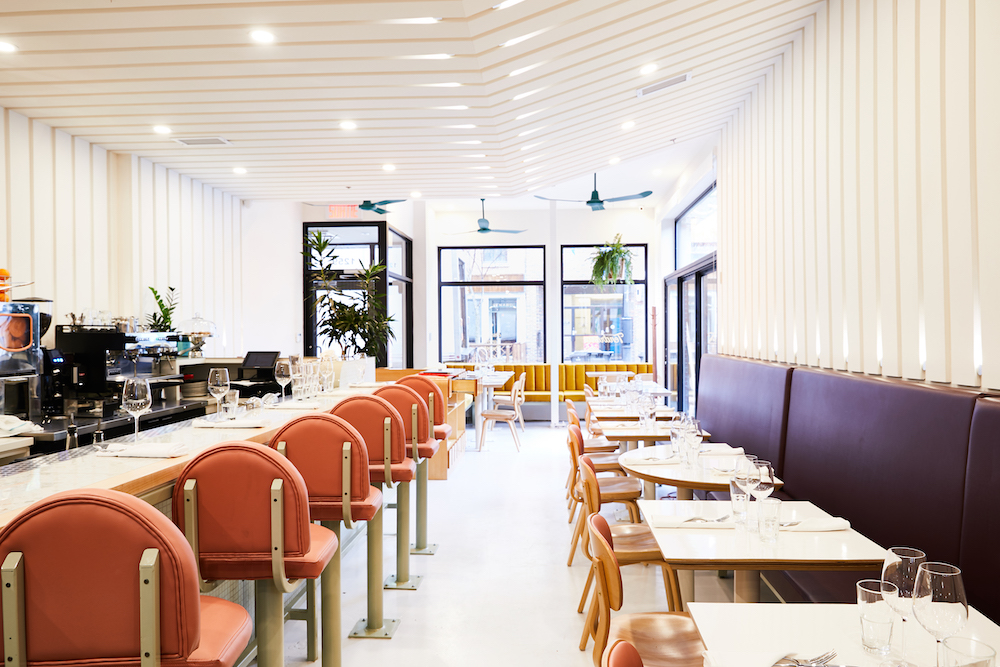
6. Square meterage per customer
Restaurant table sizes will often vary depending on the style of service and the preferences of the owners. “The size of the table is often selected for how that particular chef wants to present the food on the table,” Antenora says.
The square meterage you allocate to each seated guest also depends on the type of restaurant you’re opening
How much square meterage you allocate to each seated guest depends on your restaurant’s service type. Here are some general guidelines for square footage per customer, based on service type:
- Fine dining: 1.7 to 1.9 square meters per customer
- Full-service dining: 1.1 to 1.4 square meters per customer
- Counter service: 1.7 to 1.9 square meters per customer
- Fast food dining: 1 to 1.3 square meters per person
Restaurant floor plan must-have’s
When you set out to design your restaurant floor plan, make sure that it includes a visual representation of each of these restaurant sections:
- Kitchen
- Dining area
- Payment station and POS system
- Entrance and waiting area
- Bar
- Restrooms
1. Kitchen
Kitchen layouts and sizes vary depending on the type of food being prepared and the volume of business. Open kitchens—where watching the chef(s) prepare the food can become a form of entertainment—have become more popular in recent years. “That forces the restaurateur to keep that kitchen very clean,” Antenora points out.
Victor Cardamone, President and CEO of New Jersey-based Mise Designs, is a CIA-trained chef who specialises in kitchen layouts. Cardamone recommends that kitchen planning happens before creating an overall floor plan for the restaurant. “If you were designing a race car, would you design the engine first or would you pick the tires first?” he says. “Without the engine, the tires are meaningless. The engine is going to drive the entire concept.”
Cardamone designscommercial kitchen layouts based on the menu, service type and the cooking techniques that the chef favours. “A steakhouse would have a much larger grill area or a charcoal operation,” he says. For restaurants that overhaul their menus each season (which is increasingly common practice) Cardamone prioritises flexibility. “We try and put in a variety of pieces of equipment that give the chef the flexibility to adapt and adjust their menu items each season.”
You also want to take into account where your kitchen staff receives orders sent to them through the point of sale system to the kitchen display system (KDS). Ideally, the KDS is placed in an area that’s easy for kitchen staff to access and minimises kitchen foot traffic—the window is a great spot (that’s restaurant slang for the warming area between the kitchen and the serving station. It’s where cooks place dishes that are ready to get run to the table.)
2. Dining area
Typically, a restaurant’s dining area, bar, restrooms and waiting area should take up about 60% of its total square footage and the remaining 40% should be reserved for the kitchen, storage and food prep space.
You also need to consider your local building code. What’s the maximum number of people you’re allowed to have in the building at once?
When designing your dining area, you need to consider how your customers and staff will move through it—design to avoid any bottlenecks. Also, assure that your dining space is flexible and can accommodate large parties.
Seating layout can impact the kind of experience a customer has, whether the space feels intimate and sedate or animated and lively, according to Antenora. “Each of these may have different table sizes and heights, as well as how those tables are placed,” he says. “Further, one may have more booths or banquette seating.” The use of hard or soft materials in the dining area impacts the space’s acoustics and the overall vibe, he adds.
Take, for example, The Donut Experiment’s floor plan, which Mise Designs developed. Donuts are cooked to order and guests can customise their donut with the condiments of their liking in the designated condiment area. Moreover, The Donut Experiment opted to have their assembly area fully on display to its customers.
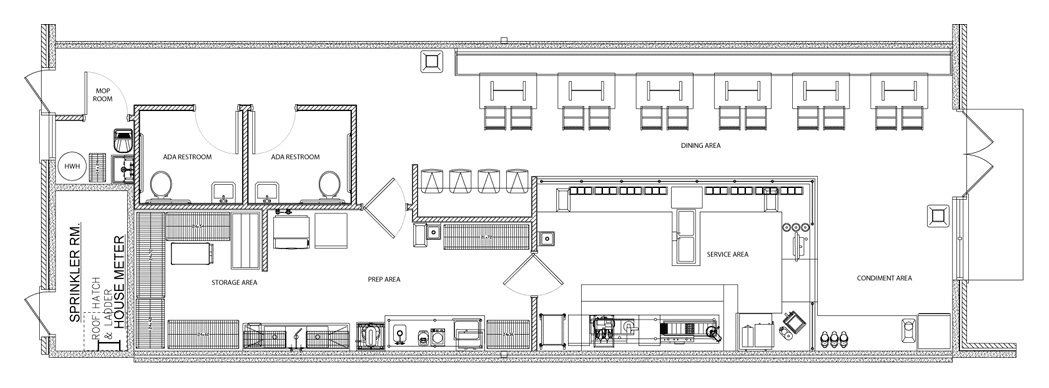
3. Payment station and POS system
Your point POS system is your restaurant’s heartbeat. It’s what servers use to place orders and fire them to the kitchen, take payments, check-in reservations and more. A restaurant has limited space in its dining area; a handheld point of sale systems enables front of house staff to serve guests from check-in to checkout from a mobile tablet.
Table-side ordering prevents the unnecessary foot traffic created by servers running back and forth from table to payment station and saves previous dining space that would otherwise be allocated to a stationary payment station.
4. Entrance and waiting area
The entrance and waiting area are oftentimes a customer’s first impression of a restaurant and, and Antenora points out, how it’s configured can have unexpected implications.
“Many restaurants are designed specifically to encourage a patron to have a drink at the bar or waiting area while they wait for their table,” Antenora says. “The size of the waiting area can vary widely regardless of whether or not a restaurant takes reservations or not, and it is largely driven by how much space the restaurateur wants to dedicate to it.”
In the example of Korus, A fine-dining restaurant, they opted for a waiting area that was separate from the dining area, equipped with its own seating area.
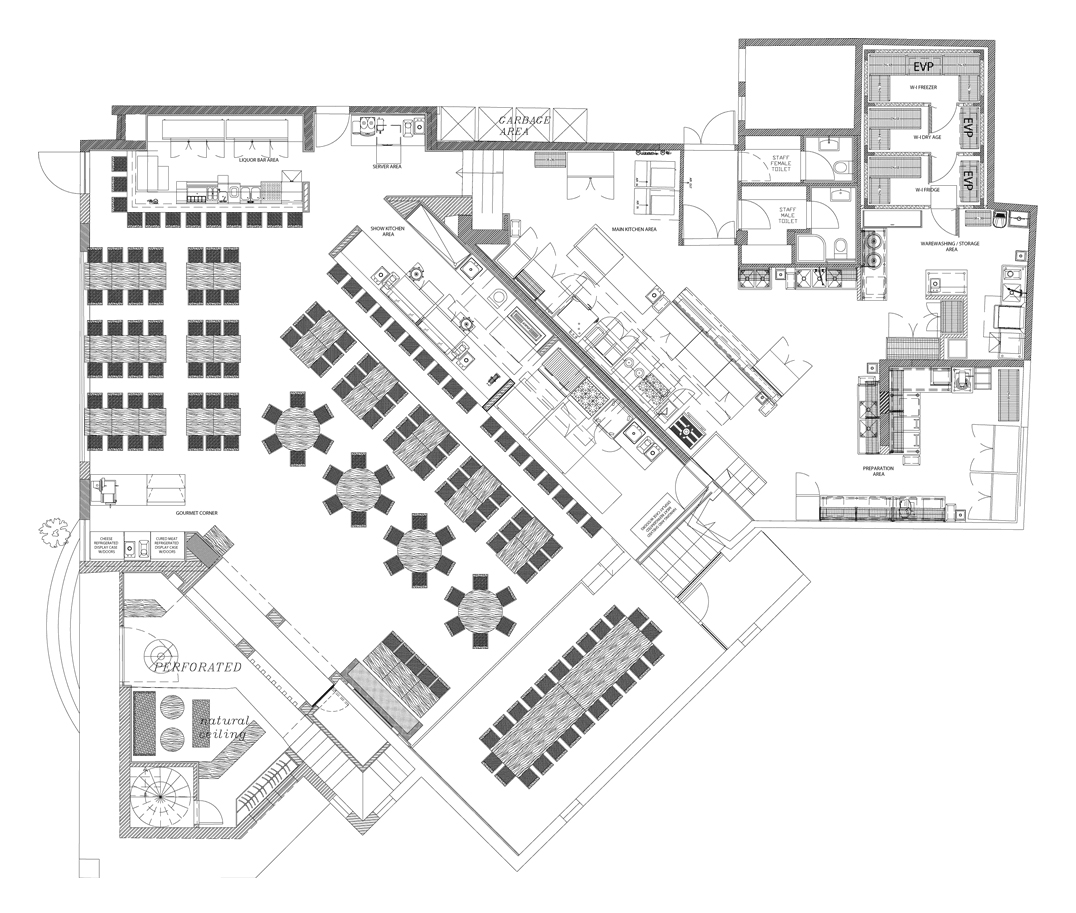
While a restaurant’s kitchen should take up 40% of total square footage, the dining area, bar, restrooms, entrance and waiting area should be taken out of the 60% space allocated to dining space. If space is too limited to fit seating in your entrance, consider directing guests to wait for their table at the bar and have a drink instead.
5. Bar
Not all restaurants have a bar, but when they do, the bar can often become a main attraction in the space.
“They’re a focal point for customers and create a sense of direction and identity of the place,” Mousavi says. “So we usually try to come up with a unique design idea for the bar piece, and then lay out the rest of the space around it.”
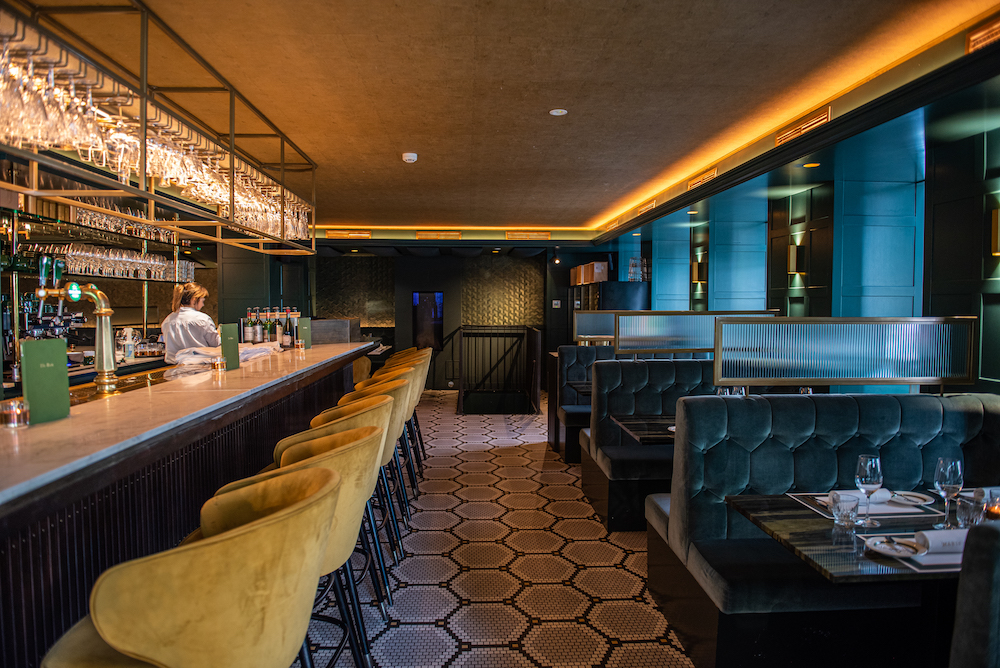
Case and point are Amsterdam-based restaurant Maris Piper. Their beautifully-decorated space features an open bar and kitchen, making their bartenders and chefs a focal part of the dining experience.
6. Restrooms
Restrooms are a necessary part of a restaurant layout but, ideally, their doors should be tucked away from the dining area.
“A good restaurant design is going to have a doorway restroom foyer you go into,” Antenora says. Clustering the restroom and kitchen plumbing together in the same area can save money with the cost of construction.
That’s precisely what Cardamone did when designing Bourbon Coffee Shop’s floor plan. The restroom and kitchen area are strategically placed near one another so that they both use the same plumbing.
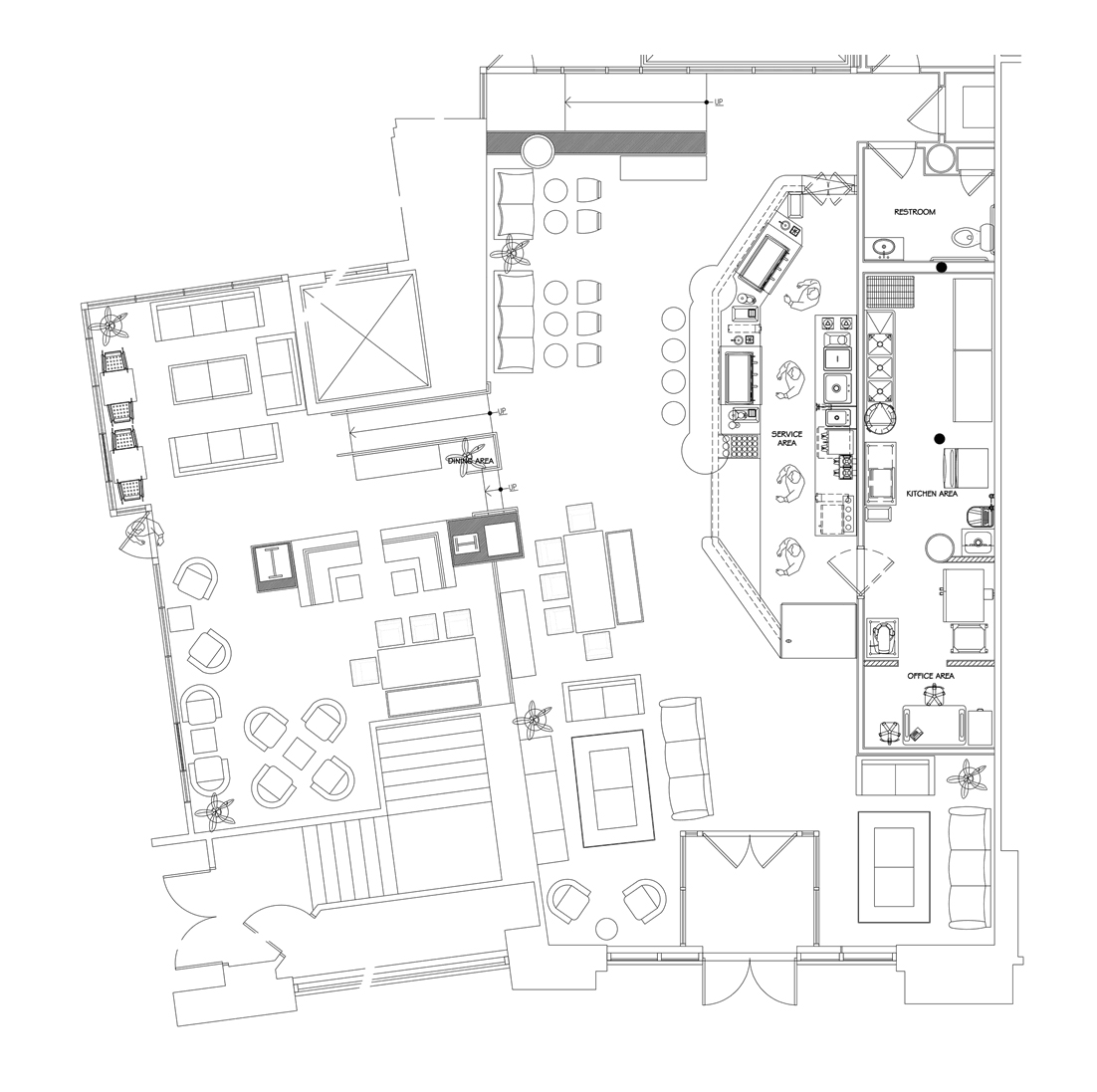
As you should be doing with your entire restaurant layout, it’s important to adhere to the ADA’s accessibility regulations. Additionally, be sure to familiarise yourself with your local regulations for how many restrooms and gender designations your restaurant needs. In certain instances, small-scale restaurants (those with fewer than 24 seats) might not need to have a restroom for their guests.
Together, your architect, interior designer and you can design an Instagrammable, memorable restroom.
Design the perfect restaurant floor plan
While certain elements of your restaurant floor plan may change over time—you might decide to add patio seating for warmer months or buy the space next door and expand your space–the basic foundations you plan out will probably remain constant.
Just remember: your goal is to create a restaurant floor plan that helps your kitchen staff work effectively, your service staff to provide top-notch service to guests and your customers to get a dining experience that makes them come back time and time again (and recommend your establishment to friends).
Restaurant floor planning requires careful consideration to find the right balance of efficiency, aesthetics while sticking to a budget. Take the time to partner with professionals, build a strong foundation and set your establishment up for long-term success. Our free white paper on the future of dining may help with your restaurant floor planning.

News you care about. Tips you can use.
Everything your business needs to grow, delivered straight to your inbox.



